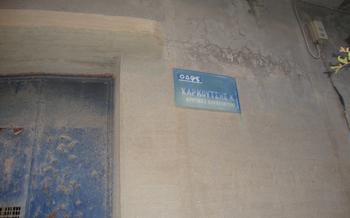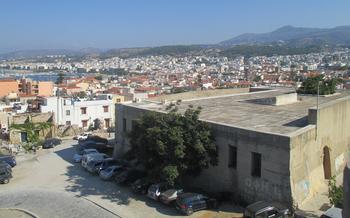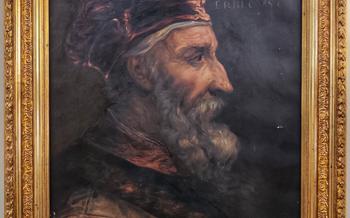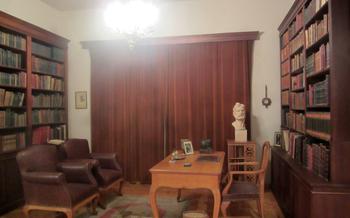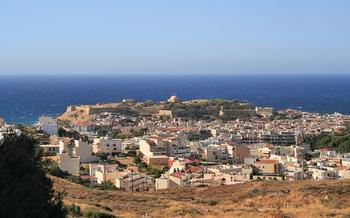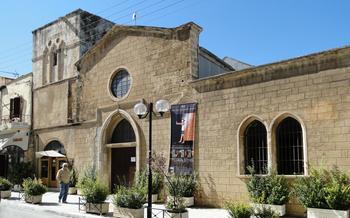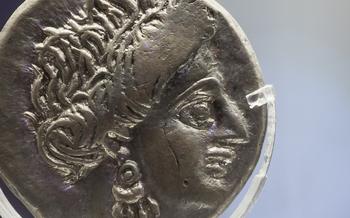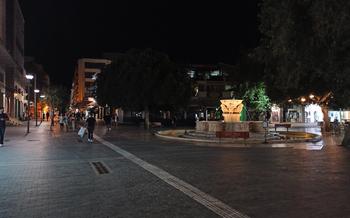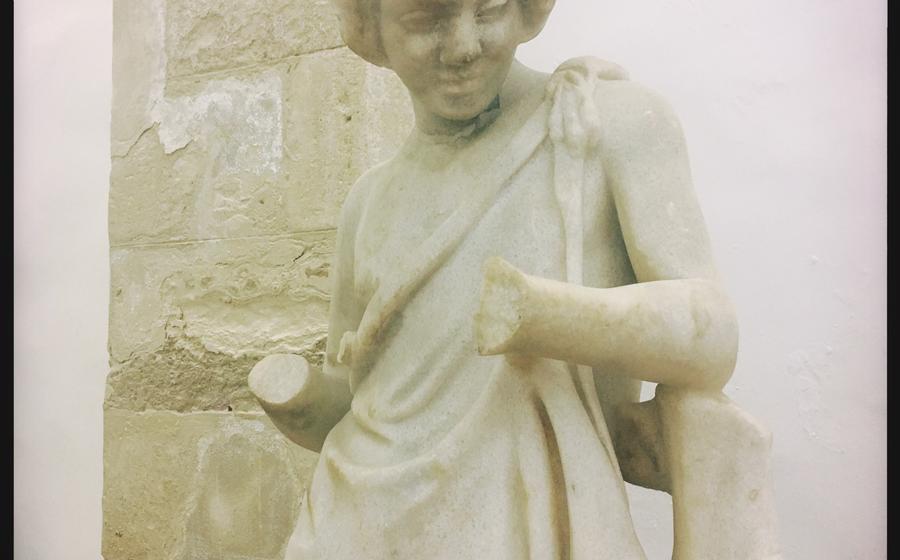
Kissamos Archaeological Museum
- Kissamos Archaeological Museum: A Treasure Trove of History
- Location and Accessibility
- Hours of Operation and Admission Fees:
- Architectural Features
- Permanent and Temporary Exhibitions
- Historical Context
- Navigating the Museum
- Museum Highlights
- Interactive Displays:
- Educational Programs
- Souvenir Shop and Publications
- Accessibility for Visitors with Disabilities:
- Photography and Social Media
- Future Plans and Developments
- Insider Tip: Unveiling Hidden Gems and Secrets
Kissamos Archaeological Museum: A Treasure Trove of History
The Kissamos Archaeological Museum stands as a testament to the rich history and cultural heritage of the Kissamos region in Crete, Greece. Established in 1964, this museum houses a remarkable collection of artifacts that provide a glimpse into the ancient civilizations that once thrived in this corner of the Mediterranean.
The museum's exhibits span various historical periods, from the Neolithic Age to the Roman era, offering visitors a comprehensive journey through time. Among the highlights of the collection are pottery, tools, jewelry, and sculptures that showcase the artistic and technological achievements of the region's ancient inhabitants.
One of the most significant contributions of the Kissamos Archaeological Museum is its role in preserving and showcasing the archaeological discoveries made in the Kissamos region. These discoveries have shed light on the development of human settlements, trade routes, and cultural interactions that took place in this part of the world throughout the centuries.
The museum's exhibits not only provide a glimpse into the past but also foster a deeper understanding of the cultural heritage that continues to shape the identity of the Kissamos region. Through its dedication to preserving and showcasing archaeological treasures, the museum serves as a vital resource for researchers, historians, and visitors alike.
Location and Accessibility
The Kissamos Archaeological Museum is strategically situated in the heart of Kissamos town, inviting visitors to delve into the region's rich history. Its address, 25 Martiou Street, places it within easy reach of other notable attractions, including the picturesque Venetian Port, the vibrant Old Town, and the pristine beaches that grace the Kissamos coastline.
Getting to the museum is a breeze, thanks to its excellent connectivity. For those arriving by public transportation, the local bus service provides convenient access to the museum's doorstep. Alternatively, driving to the museum is equally convenient, with ample street parking available in the vicinity.
Hours of Operation and Admission Fees:
The Kissamos Archaeological Museum welcomes visitors daily, except for Mondays, from 8:00 AM to 3:00 PM. The museum observes the standard Greek public holidays.
Admission fees are reasonable, with a standard ticket costing 6 euros. Reduced rates are available for students, seniors, and children, while free admission is granted to individuals with disabilities and their companions.
The museum offers guided tours in Greek and English for groups of 10 or more visitors, by prior arrangement. These tours provide an in-depth exploration of the museum's collection and offer insights into the history and significance of the artifacts.
Audio guides are also available for rent, allowing visitors to explore the museum at their own pace and in their preferred language. These guides are available in multiple languages, ensuring that visitors from all over the world can enjoy a comprehensive and enriching experience.
Architectural Features
The Kissamos Archaeological Museum is housed in a remarkable building that has its own historical significance. The structure was originally constructed as a Turkish mosque in the 17th century, during the Ottoman era in Crete. The architectural style of the mosque reflects the influence of the Ottoman Empire, with its distinctive dome and minaret. After the liberation of Crete from Ottoman rule in the 19th century, the building underwent renovations and was converted into a museum in 196
Today, the museum retains many of its original architectural features, providing visitors with a glimpse into the region's past. The interior of the building features arched doorways, vaulted ceilings, and intricate stone carvings that showcase the craftsmanship of the era. The combination of historical and modern elements creates a unique and visually appealing space that complements the exhibits displayed within.
Permanent and Temporary Exhibitions
The Kissamos Archaeological Museum houses a captivating permanent collection that showcases an array of artifacts from the region's rich past. Among the highlights are exquisite Minoan pottery, intricately carved Roman sculptures, and impressive Venetian coins. These artifacts provide a glimpse into the diverse cultures that have shaped the history of Kissamos.
In addition to the permanent displays, the museum also features temporary exhibitions that explore specific themes or periods in greater depth. These exhibitions often showcase new archaeological discoveries or collaborations with other institutions. Visitors can expect to encounter a diverse range of artifacts, from ancient tools and weapons to exquisite jewelry and artwork.
Historical Context
Kissamos, a town in northwestern Crete, holds a significant place in the region's rich history. Archaeological discoveries in the area have illuminated the town's past, revealing its origins as a Minoan settlement dating back to the Bronze Age. During this period, Kissamos was a thriving center of maritime trade and cultural exchange, as evidenced by the impressive Minoan artifacts unearthed in the region.
In the Classical era, Kissamos fell under the influence of the powerful city-state of Polyrrhenia, which controlled much of western Crete. The town became a vital port and commercial hub, connecting Polyrrhenia with the wider Mediterranean world. This period saw the construction of fortifications and other significant structures, reflecting Kissamos's growing importance.
Later, during the Roman and Byzantine periods, Kissamos continued to play a strategic role. The town's strategic location on the coast made it a crucial defensive outpost and a gateway to Crete's interior. Archaeological finds from this period, including coins, pottery, and architectural remains, provide glimpses into the town's vibrant past under Roman and Byzantine rule.
Navigating the Museum
The Kissamos Archaeological Museum is designed to provide a seamless and engaging visit for all its visitors. The museum is comprised of several galleries, each dedicated to a specific theme or period in the region's history. As you enter the main exhibition hall, you'll be greeted by a chronological display that takes you through the major historical eras of Kissamos, from the Neolithic period to the Roman era.
One of the highlights of the museum is the "Treasures of Kissamos" gallery, which showcases some of the most impressive artifacts discovered in the region. Here, you'll find exquisite pottery, intricate jewelry, and rare sculptures that offer a glimpse into the lives and traditions of ancient Kissamians.
For those interested in learning more about the region's maritime history, the "Seafaring and Trade" gallery is a must-visit. It features a collection of shipwrecks, navigation instruments, and trading goods that shed light on the vital role Kissamos played in Mediterranean commerce.
To make the most of your visit, consider following a suggested self-guided tour route. These routes are designed to take you through the museum's galleries in a logical order, ensuring you don't miss any of the key highlights. Maps and brochures with suggested routes are available at the museum's information desk.
Don't be afraid to take your time and explore the museum at your own pace. Take advantage of the informative signage, which provides detailed explanations about the artifacts and their historical context. If you have any questions or need further assistance, the museum staff is always on hand to help.
Museum Highlights
Among the many captivating exhibits, several stand out as must-sees for any visitor. The Bronze Statue of Apollo, discovered in the ancient city of Falasarna, is a remarkable representation of the Greek god, capturing his youthful grace and divine presence. Another highlight is the Roman Mosaic of Dionysus, found in the nearby village of Polyrrhenia. This intricate mosaic depicts the Greek god of wine and revelry surrounded by his followers, offering a glimpse into ancient religious practices and artistic traditions.
For history buffs, the Minoan Artifacts from the archaeological site of Kasteli Kissamou are a treasure trove of insights into the Bronze Age civilization of Crete. These artifacts, including pottery, tools, and jewelry, provide a tangible connection to the region's rich past.
The museum also houses a collection of Byzantine Icons, showcasing the religious art and iconography that flourished during the Byzantine Empire. These icons, with their vibrant colors and intricate details, offer a glimpse into the spiritual and artistic heritage of the region.
Interactive Displays:
The Kissamos Archaeological Museum offers a range of interactive displays and multimedia presentations that enhance the visitor experience and make history come alive. These interactive elements are designed to engage visitors of all ages and provide a deeper understanding of the museum's collection.
One of the highlights is the virtual reality experience, which allows visitors to immerse themselves in the ancient city of Kissamos and explore its landmarks as if they were there. Visitors can also use touchscreens to explore 3D models of artifacts, zoom in on intricate details, and learn more about their significance.
For a hands-on experience, the museum offers educational games and puzzles that test visitors' knowledge of ancient history and archaeology. These interactive games are a fun and engaging way to learn about the past and reinforce the information presented in the exhibits.
Additionally, the museum features audiovisual presentations that bring the history of Kissamos to life. These presentations combine stunning visuals, sound effects, and narration to immerse visitors in the region's rich cultural heritage.
Educational Programs
The Kissamos Archaeological Museum offers a range of educational programs designed to engage visitors of all ages and backgrounds. Children can participate in interactive workshops where they learn about archaeology and ancient history through hands-on activities, storytelling, and games. These workshops are led by experienced educators who make learning fun and engaging. The museum also organizes lectures and talks by renowned archaeologists and historians, providing visitors with in-depth insights into the latest research and discoveries in the field. These events are open to the public and offer an excellent opportunity to learn more about the region's rich past.
For schools and groups, the museum offers guided tours tailored to specific age levels and interests. These tours provide a comprehensive overview of the museum's collection and allow students to explore the exhibits in greater depth. Teachers can also request customized tours that align with their curriculum and learning objectives.
The museum's educational programs are an integral part of its mission to promote knowledge and understanding of the region's cultural heritage. By engaging with visitors of all ages, the museum aims to foster a lifelong appreciation for archaeology and history. To inquire about upcoming programs or to arrange a guided tour, visitors can contact the museum's education department.
Souvenir Shop and Publications
The Kissamos Archaeological Museum boasts a well-stocked gift shop where visitors can purchase a variety of souvenirs and mementos to commemorate their visit. From replicas of ancient artifacts to traditional Cretan handicrafts, there's something for everyone. You'll find a wide selection of books and publications related to the museum's collection, including guidebooks, catalogs, and scholarly works. These publications offer a deeper dive into the history and significance of the exhibits, providing a lasting reminder of your time at the museum.
Accessibility for Visitors with Disabilities:
The Kissamos Archaeological Museum recognizes the importance of fostering inclusivity and accessibility for all its visitors. The museum is fully equipped with wheelchair ramps and elevators, providing seamless navigation throughout its galleries and exhibition spaces. Visitors who require assistance from sign language interpreters or audio descriptions should contact the museum in advance to arrange for these services. The helpful and accommodating staff is always willing to assist visitors with disabilities, ensuring they have a fulfilling and enjoyable museum experience. It is heartening to see how the museum goes the extra mile to create an environment that welcomes and embraces everyone, regardless of their abilities.
Photography and Social Media
The Kissamos Archaeological Museum welcomes photography and videography for personal use, allowing visitors to capture their memorable moments and share their experiences with the world. The museum encourages visitors to share their photos and videos on social media platforms, using relevant hashtags to connect with a broader audience. The museum staff is always excited to see visitors' perspectives and interpretations of the exhibits. To ensure the best photography experience, it is advisable to use a flash-free camera setting to protect the artifacts and avoid disturbing other visitors. By sharing your museum adventures on social media, you not only preserve your memories but also contribute to promoting the cultural heritage and history of Kissamos.
Future Plans and Developments
The Kissamos Archaeological Museum is poised for exciting developments in the near future. A major renovation project is underway, aiming to enhance the visitor experience and showcase the rich collection in a more engaging and comprehensive manner. The renovation includes the expansion of exhibition spaces, the incorporation of state-of-the-art technology, and the creation of new interactive exhibits.
In line with its mission to promote the cultural heritage of the region, the museum is planning a series of upcoming exhibitions that will delve deeper into the fascinating history of Kissamos and its surrounding areas. These exhibitions will feature new archaeological discoveries, highlight lesser-known aspects of local history, and explore the connections between the region's past and present.
These developments reaffirm the museum's commitment to preserving and sharing the cultural heritage of Kissamos with visitors from around the world. The renovated museum and upcoming exhibitions promise to offer an even richer and more immersive experience, further establishing the Kissamos Archaeological Museum as a must-visit destination for history enthusiasts and culture seekers.
Insider Tip: Unveiling Hidden Gems and Secrets
As you wander through the Kissamos Archaeological Museum, keep an eye out for secret spots and hidden gems that may escape the notice of casual visitors. One such treasure is the "Secret Room", located in the museum's lower level. This room houses a collection of rare and unique artifacts that are not on display in the main galleries. To access the Secret Room, ask a museum staff member for directions.
Another hidden gem is the "Curator's Corner". This special section of the museum features rotating exhibits curated by the museum's director. Here, you can get an insider's perspective on the museum's collection and the latest archaeological discoveries in the region.
For the best museum experience, plan your visit during the shoulder season (April-May and September-October) to avoid the summer crowds. This way, you'll have more time toじっくりexplore the exhibits and engage with the museum staff.
